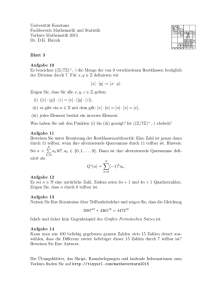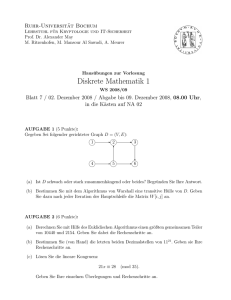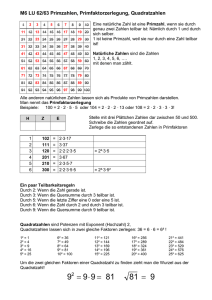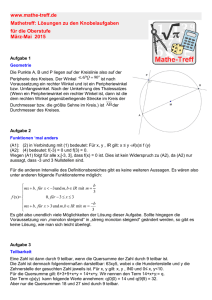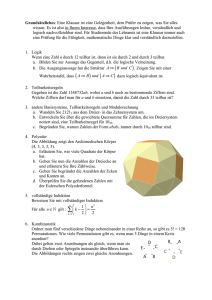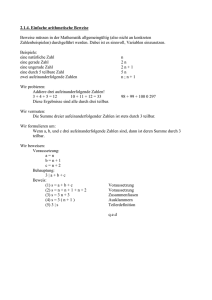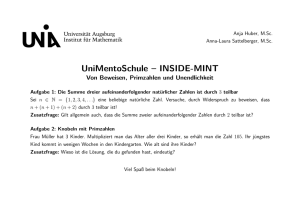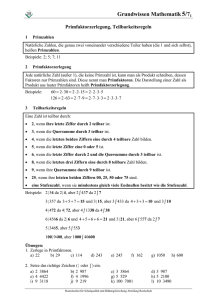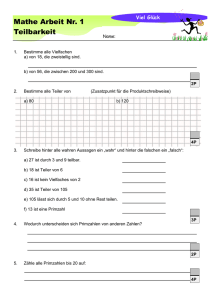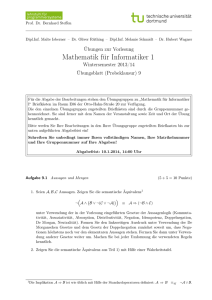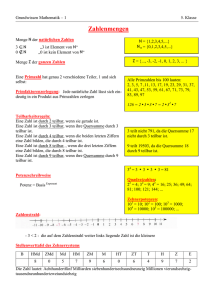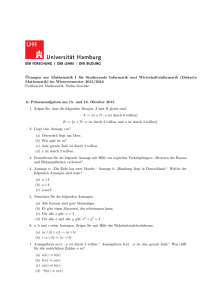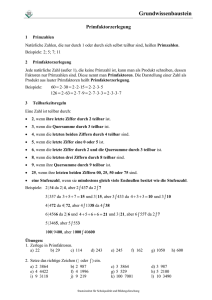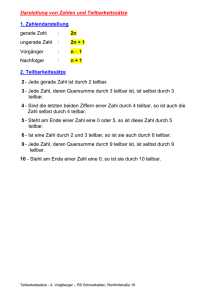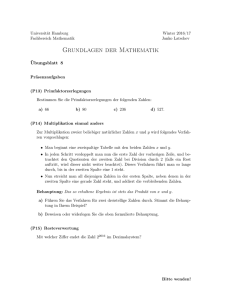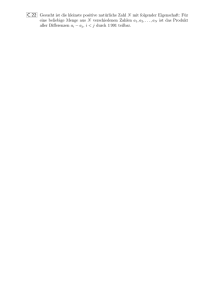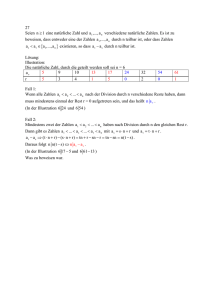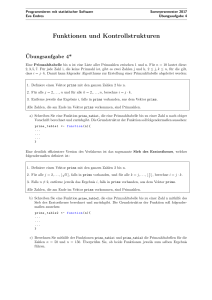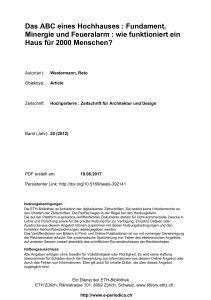Mathematische Kuriositäten
Werbung
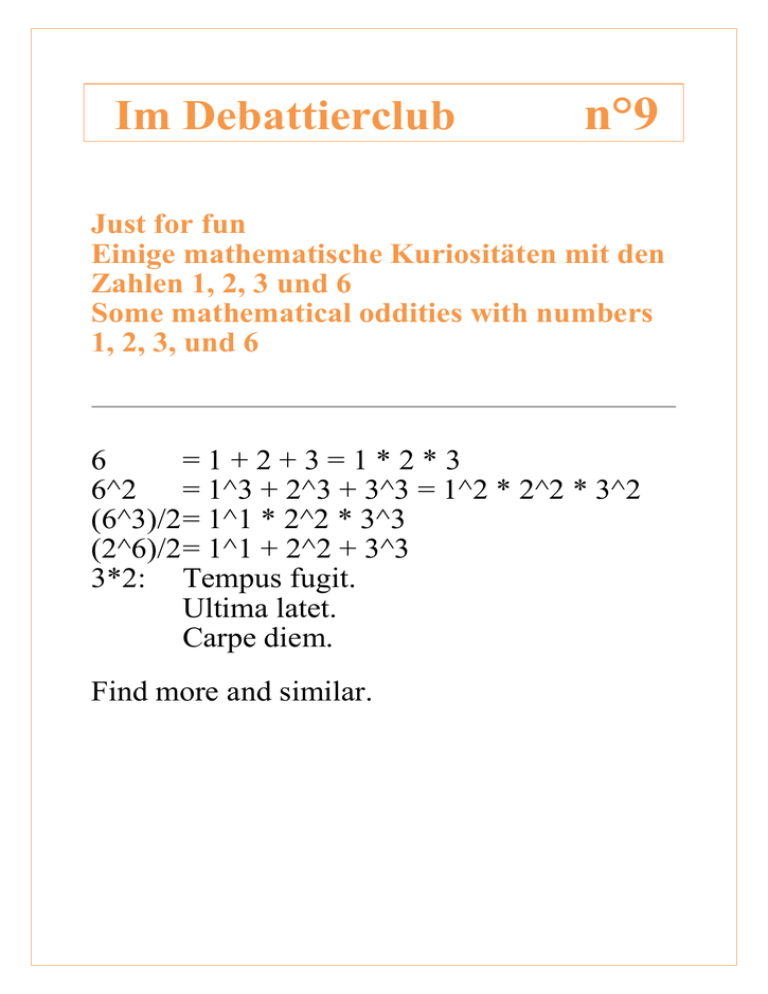
Im Debattierclub n°9 Just for fun Einige mathematische Kuriositäten mit den Zahlen 1, 2, 3 und 6 Some mathematical oddities with numbers 1, 2, 3, und 6 6 =1+2+3=1*2*3 6^2 = 1^3 + 2^3 + 3^3 = 1^2 * 2^2 * 3^2 (6^3)/2 = 1^1 * 2^2 * 3^3 (2^6)/2 = 1^1 + 2^2 + 3^3 3*2: Tempus fugit. Ultima latet. Carpe diem. Find more and similar. 9.1 163fe ** 1+2*3^4 = 163 2 4 4 8 1 4 4 ** [4 ] 2 i=0 i i=0 i 1 4 8 [4 ] 163 2 4 ** 163, 2, e, almost integer 163 31.9999987... 25 ln163 163 e 25 162.9999673... 163 ** 163 and Feigenbaum constant 4.669201609102990... 4*1 =4 122 1 ... 4* 1632 4.669201 5209... 10 1 ... 163 122 4*122 31 1 ... 2 4* 163 2 4*163 10 102 30 1 ... 2 163 163 4.66920160933975... Ist diese doch recht gute Approximation ein Zufallstreffer und eine Sackgasse oder lässt sie sich auf irgendeine Weise systematisch ad infinitum fortsetzen? ** 163, 2, and a digit transposition 28 1 163 1 1 1.570 552147... 1 1 2 1 1 3 23 1 355 1 1 226 1 1 1 1 3 32 = 1.5707964601... 2 ** 163, e, , almost integer e3 163 640320.0000000006049... e 163 262537412640768743.99999999999925007... ** 163 and primes 1 2 163 The Euler polynomial f(x) = (x ) 2 4 generates for x [0,39] only primes, esp. the Bernoulli marker f(25) = 691. Why is that so? Does f(x) generate for larger x another prime sequences? Untersuchen Sie die Primzahlerzeugung a 163 mit dem Polynom g(x) = (x ) 2 2 2 für a,x . ** 163 scf curiosities 35 1 1 1 163 2 1 2*13 1 37 13 163 2 1 1 1 2 1 13 1 1 163 12 1 1 2 1 1 1 13 1 1 1 6 13 12 1 1 163 6 1 1 1 1 12 9.2 1, 2, 5, 6, and e; almost integer (52 1) 2 2 (2 1) 62 1 e 1 (5 1) 2 (2 1) 2 6 1 613 35 e 44.99999999993962... 37 991 2 2 9.3 5-Rasenmäher/5-lawnmower 5100000000 1510000000 0151000000 0015100000 =6665999 det 0001510000 0000151000 0000015100 0000001510 0000000151 0000000015 Quersumme/digit sum(6665999)=2*52 alternierende Quersumme/ alternating digit sum(6665999) 2*5 5 6665999=U 2*5 2 U n x - Chebyshev polynomial of the second kind Find other lawnmower expressions. 9.4 77 Ich bin 77, Geburtsjahrgang 1936 Na und, aus diesen Zahlen lässt sich doch was herausholen! 2 22 ** 1936 44 = 2 *112 ** 77 = 7*11 ist eine Pseudoprimzahl 7 – größte einstellige Primzahl 11 – kleinste zweistellige Primzahl ** 77 42 52 62 Summe dreier aufeinanderfolgender Quadratzahlen ** 77 = 2+3+5+7+11+13+17+19 Summe der ersten acht aufeinanderfolgenden Primzahlen ** 77 ist die kleinste natürliche Zahl mit der multiplikativen Beharrlichkeit 4. http://de.wikipedia.org/wiki/Querprodukt ** Alle natürlichen Zahlen > 77 lassen sich als Summe natürlicher Zahlen darstellen so, dass die Summe der Reziproken dieser Zahlen 1 ist. Beispiel: 78 = 2+6+8+10+12+40, 2-1 + 6-1 + 8-1 + 10-1 + 12-1 + 40-1 = 1 77 [8;1,3,2,3,1,16,...] 7-freie Kettenbruchentwicklung 1 106 ** 0.012987... 12987* 77 1 106 106 106 13* 27 *37* 13*999* 6 1 10 1 106 6 10 33 *13*37* 1 106 1 106 ** 0.012987... 12987* 77 1 106 106 106 13* 27 *37* 13*999* 6 1 10 1 106 106 3 3 *13*37* 1 106 ** 9 106 ** 0.116883... 116883* 77 1 106 6 10 = 9*33 *13*37 * 1 106 13 106 0.168831... 168831* 77 1 106 6 10 = 13*33 *13*37 * 1 106 53 106 0.688311... 688311* 77 1 106 6 10 = 53*33 *13*37 * 1 106 68 106 0.883116... 883116* 77 1 106 6 10 = 68*33 *13*37 * 1 106 64 106 0.831168... 831168* 77 1 106 6 10 = 64*33 *13*37 * 1 106 24 106 0.311688... 311688* 77 1 106 6 10 = 24*33 *13*37 * 1 106 33 *13*37 *77 33 *7 *11*13*37 999999 27 * 37 999; 13*77 = 1001; 999*1001 = 999999 116883 883116 ** Ein naher Verwandter: 31*1272 = 49999 77*127 = 9779 ** Euler*1707 & Gauß*1777 1707 1 22 1 77 5 1 1 12 1777 1 23 1 77 12 1 1 5 ** Interpretieren Sie vorstehende Wertekonstellationen. Siehe hierzu http://de.wikipedia.org/wiki/Teilbarkeit ** Eine Zahl ist genau dann durch 7 teilbar, wenn ihre alternierende 3er-Quersumme durch 7 teilbar ist. ** Eine Zahl ist genau dann durch 11 teilbar, wenn ihre alternierende Quersumme durch 11 teilbar ist. ** Eine Zahl ist genau dann durch 13 teilbar, wenn ihre alternierende 3er-Quersumme durch 13 teilbar ist. ** Eine Zahl ist genau dann durch 77 teilbar, wenn ihre alternierende 3er-Quersumme durch 77 teilbar ist. ** Eine Zahl ist genau dann durch 27 teilbar, wenn ihre nichtalternierende 3er-Quersumme durch 27 teilbar ist. . ** Eine Zahl ist genau dann durch 37 teilbar, wenn ihre nichtalternierende 3er-Quersumme durch 37 teilbar ist. ** Teilbarkeit durch 31 und 127??? ** Eine natürliche Zahl n ist genau dann durch 77 teilbar, wenn ihre alternierende 3er-Quersumme durch 77 teilbar ist. Beispiel n=322456904 alternierende 3-er Quersumme= 904-456+322=770 77|770 77|322456904 ** Teilbarkeit durch 7, rekursiver Test 7ǀn genau dann, wenn 7ǀ(abs(n/)n) mit n/ = div(n,8) + rest(n,8) n/ = div(n,10) - 2rest(n,10) n/ = 2div(n,100) + rest(n,100) n/ = div(n,1000) - rest(n,1000) Suchen Sie ähnliche rekursive Teilbarkeitskriterien für 77. ** Find more ** 17777771 = 11*1616161 ** Next birthday outlook 78 12 i i=1 78 78 [8;1, 4,1,16,...] 2 6 8 10 12 40 1 1 1 1 1 1 1 2 6 8 10 12 40 77 *78 (77 1 781 ) 1 76*77 *78 77 *78*79 6006 76 76 [ ; 1, 2, 1, ] 2 2 456456 474474 ** Jewish lunar month continued fraction The length of the mean lunar month in the Jewish traditional calendar is 29.53059 days. m = 29.53059 has an interesting simple continued fraction representation: m 29.53059 [29;1,1, 7 ,1, 2,18, 2,1,1,1,13] sum 24 sum 24 The total sum of the scf-elements is 77. ** With the abbreviation 8 times 177777777 178 we obtain the „mirror quotient“ 71n f(n) = n 17 lim f(n) = 4 ; lim df(n) = 10 , n n lateral 160n g(n) = n 17 lim g(n) = 9 ; lim dg(n) = 10 . n n f(n+1) f(n) df(n) = f(n+2) f(n+1) Discuss these results. Find more! 9.5 A deep well We consider the following algorithms. A1 Input: natural number x := natural number i := 0 repeat ** factorize x into prime factors in ascending order; ** x := concatenation of these prime factors; ** i := i+1 until x is prime prime := x; n := i Output: prime; n A2 Input: natural number x := natural number i := 0 repeat ** factorize x into prime factors in ascending order; ** x := sum of these prime factors; ** i := i+1 until x is prime prime := x; n := i Output: prime; n Discuss these algorithms by means of examples: ** Relation input – output ** Do the recursion terminate for all natural numbers input; in search for the “wormholes”. Or conjecture: The recursion terminates for all natural numbers input to a prime. ** Graph “n = f(natural number input)” Natural number input = 8 = hot spot A1 i x(i) 0 8=2*2*2 1 222=2*3*37 2 2337=3*19*41 3 31941=3*3*3*7*13*13 4 33371313=3*11123771 5 311123771=7*149*317*941 6 7149317941=229*31219729 7 22931219729=11*2084656339 8 112084656339=3*347*911*118189m 9 3347911118189=11*613*496501723 10 11613496501723=97*130517* 917327 11 97130517917327=53*1832651281459 12 531832651281459=3*3*3*11*139*653* 3863*5107 13 3331113965338635107= 3331113965338635107 is prime, stop Output: prime=3331113965338635107; n=13 A2 i x(i) 0 8=2*2*2 1 222=2*3*37 2 42=2*3*7 3 12=2*2*3 4 7 = 7 is prime, stop Output: prime=7; n=4 Natural number input = 20 = hot spot A1 i x(i) 0 20=2*2*5 1 225=3*3*5*5 2 3355=5*11*61 3 51161=11*4651 4 114651=3*3*12739 5 3312739=17*194867 6 17194867=19*41*22073 7 194122073=709*273797 8 709273797=3*97*137*17791 9 39713717791=11*3610337981 10 113610337981=7*3391*4786213 11 733914786213= 3*3*3*3*7*23*31*1815403 12 3333723311815403= 13*17*23*655857429041 13 131723655857429041= 7*7*2688237874641409 14 772688237874641409= 3*31*8308475676071413 15 3318308475676071413= 3318308475676071413 is prime; stop Output: prime=3318308475676071413; n=15 A1 Nat.num.inp. 1 2 3 4 5 6 7 8 9 10 11 12 13 14 15 16 17 18 19 20 21 22 23 n 1 1prime 1 2 1 1 1 13 2 4 1 1 1 5 4 4 1 1 1 15 1 1 1 24 25 26 27 28 29 30 31 32 33 34 35 36 37 38 39 40 41 42 43 44 45 46 47 48 2 3 4 4 1 1 2 1 2 1 5 3 2 1 2 1 9 1 2 1 9 6 1 1 15 49 50…76 77 78 79 80 81 82 83 84 85 86 87 88 89 90 91 92 93 94 95 96 97 >46 2, 1, 1, 1, 1, 2, 3, 2, 1, 1, 2, 1, 3, 1, 6, 19, 1, 1, 2, 3, 1, 1, 3, 1, 2, 2, 3 >45 8 1 31 9 1 1 1 3 17 18 2 1 3 7 2 1 2 4 28 1 98 99 100..111 112 113…145 146 147…200 201…233 234 235…241 242 243…272 273 1 2 3, 1, 2, 1, 14, 25, 2, 1, 2, 1, 2, 1 >43 1, 3, 1, 18, 1, 4, 4, 17, 4, 2, 24, 3, 12, 1, 7, 31, 13, 0, 4, 1, 2, 11, 14, 1, 3, 1, 2, 1, 1, 3, 12, 4 >51 5, 1, 1, 10, 1, 3, 6, 1, 2, 6, 1, 2, 1, 17, 12, 1, 1, 5, 1, 1, 1, 18, 6, 8, 1, 1, 1, 2, 1, 10, 1, 15, 1, 24, 1, 1, 5, 15, 44, 6, 1, 17, 3, 6, 1, 11, 1, 2, 6, 7, 1, 1, 1, 29 1, 4, 17, 4, 1, 2, 1, 30, 2, 1, 1, 16, 3, 5, 2, 5, 4, 16, 1, 1, 3, 12, 1, 9, 14, 1, 1, 19, 1, 5, 2, 1, 1 >42 1,5, 1, 3, 1, 12, 1 >38 16, 2, 1, 1, 1, 5, 1, 3, 1, 5, 1, 2, 1, 14, 1, 6, 3, 3, 1, 1, 1, 1, 9, 1, 1, 1, 1, 3, 1, 2 >40 Is this all only an algorithmic finger exercise or is there any application (f.e. generation of special large primes, cryptography)? XXL deep wells (n>40) exist for the inputs 49, 77, 112, 146, 185, 234, 242, 273, 284, 300, 312, 320, 322, 326, 328, 336, 352, 363, 407, 412, 414, 460, 495, 537, 542, 548, 556, 558, 576, 592, 596, … Foto: Arne Stoschek
